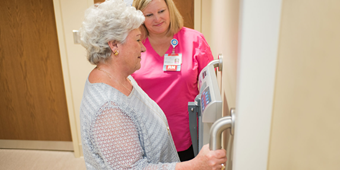7 Great Reasons to Get Moving after Menopause

Answer a few questions and we'll provide you with a list of primary care providers that best fit your needs.
If you’re experiencing the dual challenges of menopause and aging, exercise is one of your best “medicines” to look and feel good.
Here are seven great reasons to keep yourself moving during and after menopause. Regular exercise:
- Helps you battle weight gain that often occurs after menopause due to declining estrogen levels
- Increases bone mass, especially when you do weight-bearing exercises such as walking, running or weight training. This is particularly important for postmenopausal women who want to prevent spinal fractures
- Improves mood. During exercise, the brain releases chemicals called endorphins that improve your mood and help relieve stress
- Lowers your risk for heart disease, high blood pressure and diabetes
- Helps raise HDL cholesterol, the “good” cholesterol
- Helps you sleep better
- Lowers your risk of lung cancer and endometrial cancer
How Much Exercise Do I Need?
You’ll gain optimal health benefits with a weekly exercise regimen that includes:
- Two hours and 30 minutes of moderate-intensity aerobic physical activity — or one hour and 15 minutes of vigorous-intensity aerobic physical activity. You can also do a combination of moderate and vigorous exercise.
- Muscle-strengthening activities on two or more days.
Do these in addition to your routine activities of daily living, such as cleaning or walking from the parking lot to your office or a store. If you’re unclear about how hard you’re working, use these guidelines:
Moderate activity
During moderate-intensity activities your heart rate increases, but you should still be able to talk comfortably. An example of a moderate-intensity activity is walking on a level surface at a brisk pace (about three to four miles per hour). Other examples include ballroom dancing, leisurely bicycling, moderate housework and waiting tables in a restaurant.
Exercise helps you battle weight gain that often occurs after menopause due to declining estrogen levels
Vigorous activity
You are doing vigorous activity if your heart rate increases significantly and you are breathing so hard that it is difficult to carry on a conversation. Examples include jogging, bicycling fast or uphill, singles tennis and pushing a hand mower.
Answer a few questions and we'll provide you with a list of primary care providers that best fit your needs.
Source: Office on Women’s Health, U.S. Department of Health and Human Services




